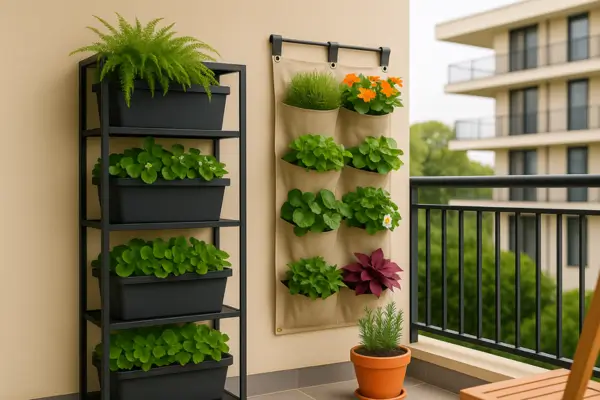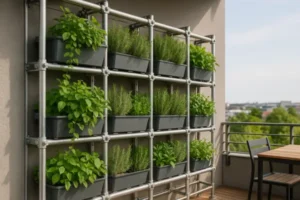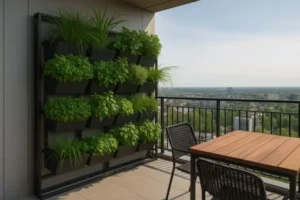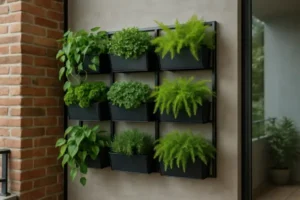Portable vertical gardens are making it easy for renters and temporary residents to bring greenery into small spaces — without the need for drilling, digging, or making anything permanent. These modular setups can liven up your balcony, kitchen, or even your bedroom wall.
With so many people moving more frequently or living in smaller homes, flexible gardening solutions have become practical, beautiful, and surprisingly easy to manage.
Here are seven portable vertical garden ideas that work especially well for renters or anyone who can’t make permanent changes to their space.
Portable Vertical Gardens with Freestanding Frames
Portable vertical gardens with freestanding frames are one of the most versatile options available. These structures don’t need walls, hooks, or any kind of attachment to the property.
They stand on their own—like a bookshelf for plants—and can be placed anywhere there’s light.
Ideal for: balconies, patios, living rooms
Freestanding frames come in different sizes, from slim units that hold a few pots to full-size racks that can support an entire mini garden.
Most are made of metal or treated wood and include slots, shelves, or hanging rails where you can place pots, fabric grow bags, or modular containers.
The beauty of this setup is how easily it adapts to different spaces. If you’re working with limited sunlight, the whole structure can be moved to follow the light during the day. If you’re hosting guests or rearranging furniture, the garden goes with the flow—no tools required.
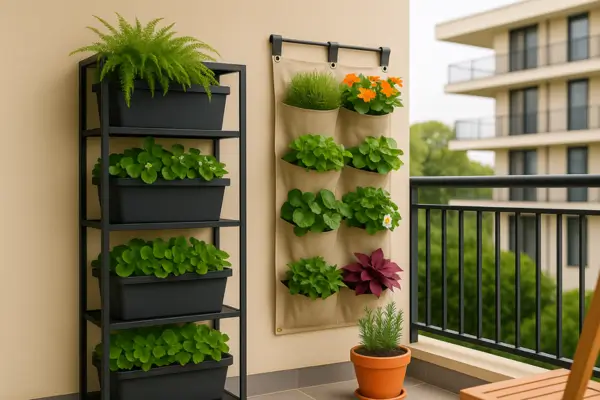
Practical tips:
- Choose lightweight frames if you plan to move the garden often.
- Consider adding wheels with locking casters for easier mobility.
- For indoor use, look for models with a built-in tray or water catch to avoid spills.
This type of garden is popular among renters who want to grow herbs or ornamentals without putting holes in walls or leaving marks behind when they move out.
Matching the Setup to Different Plant Types
Not every plant thrives in the same container or lighting condition, and freestanding frames let you mix and match with ease. Here’s how to make the most of that flexibility:
- For herbs and leafy greens: Use shallow pots on upper shelves where they’ll get the most sunlight.
- For trailing or vining plants: Position them on higher tiers so they can hang naturally, or use hooks on the side of the frame.
- For root vegetables or moisture-loving plants: Choose deeper containers placed lower, where it’s easier to water and manage.
This type of adaptability means you don’t have to commit to one gardening style. You can test new plants, change your layout, and keep things fresh without extra hardware or setup time.
Turning It Into a Functional Part of Your Home
Beyond growing plants, freestanding vertical gardens can become a living part of your everyday routine. Here’s how people are using them in practical ways:
- By the kitchen door: Fresh herbs at arm’s reach make cooking simpler and more enjoyable.
- Next to a reading corner: A mix of greenery and aroma plants like lavender adds a sense of calm.
- As a natural divider: Larger freestanding units can subtly separate living areas in open-plan spaces.
The idea is to think of your vertical garden not just as decor, but as something that supports your habits—whether it’s watering in the morning, clipping herbs at lunch, or just having greenery in view while you work or relax.
Hanging Portable Vertical Gardens with Over-the-Rail Systems
When floor space is limited, portable vertical gardens that hang over balcony or deck railings offer a flexible way to grow plants without making any structural changes.
These setups are especially useful for people in apartments, short-term housing, or anyone queuing every square inch of usable space for something practical or beautiful.
They rely on balance, not hardware. No nails, no drilling—just brackets that grip the railing. With a few small containers or fabric panels, you can turn a plain balcony edge into a productive garden space.
Ideal for: apartment balconies, deck rails, compact terraces
Over-the-rail planters come in many forms: soft fabric pockets, modular wooden boxes, vertical pouches, and even recycled materials. Each has its own way of holding soil and water.
Some hang flat against the rail, while others extend outward like a mini balcony shelf. The common factor is mobility. You can set them up in minutes, and take them down just as quickly.
They work well in places where permanence isn’t an option—but flexibility is.
How to Choose a Setup That Holds Up Over Time
Not all over-the-rail systems are built the same. Some look great when empty but struggle under the weight of moist soil and maturing plants. Others don’t fit securely on wider or rounded railings.
Here’s what makes a real difference:
- Adjustable brackets or straps: These ensure a snug fit, whether you have metal rails, wood fencing, or a concrete edge.
- Drainage design: Plants sitting in soggy soil won’t last. Look for built-in drainage holes and trays, especially if placing the system over indoor-adjacent balconies.
- Weather resistance: Plastic or polyester fabrics tend to last longer in full sun. Wood may look nicer but will need treatment to stay intact.
- Weight distribution: Balanced weight is crucial—especially if you’re using containers with deeper soil. Reinforced stitching or thicker panels help prevent sagging.
Also, avoid systems that rely on adhesives or suction cups. They rarely hold up in real-world conditions.
Which Plants Grow Best in Hanging Balcony Systems
Because these vertical gardens hang off the side of the balcony, they’re more exposed to air, sun, and wind. That means shallow-rooted, resilient plants are the safest bet—especially if you’re new to vertical gardening.
These plant types usually perform well:
- Quick-harvest herbs: Chives, thyme, mint, and oregano adapt easily to small spaces and don’t require deep pots.
- Compact vegetables: Lettuces, spinach, and bok choy can thrive in fabric pockets with steady watering.
- Edible flowers: Nasturtiums and pansies bring color and function—they’re beautiful and can be used in salads.
- Low-maintenance blooms: Marigolds and petunias do well in sunlight and add visual balance to green-heavy setups.
If you want something truly eye-catching, consider mixing edible plants with flowers. Not just for variety, but to attract pollinators—especially if your balcony faces open air.
How to Prevent Common Issues: Heat, Wind, and Water Loss
One downside of rail-hung systems is exposure. The same position that gets them great sunlight can also dry out the soil fast—or leave plants vulnerable to wind stress. But a few small adjustments can make all the difference in plant health.
Here’s how to manage it:
- Use mulch or coco liner in each container: It slows down evaporation and helps keep roots cool.
- Add wind blockers when needed: A bamboo screen or tall planter behind the setup can reduce wind without blocking light.
- Water in the morning, not evening: Morning watering lets plants absorb moisture before the sun gets intense. Avoid evening watering—it can encourage mold or root rot if temperatures drop fast.
- Rotate containers every week: Plants on the outside edge get more sun and wind. Rotating helps balance growth and reduces stress.
- Install a small drip line if you’re using multiple containers: It keeps watering consistent and saves time, especially during summer.
With these steps, you don’t need to baby your plants. Just check in regularly, adjust with the weather, and the setup does most of the work.
Tiered Ladder-Style Vertical Gardens
Tiered ladder-style setups are one of the most stylish and functional ways to create portable vertical gardens. They lean gently against a wall or railing, using gravity and their own weight for stability—no drilling or mounting involved.
This makes them especially practical for renters who want a garden but can’t modify their space.
Ideal for: renters who want a decorative indoor or outdoor solution
These garden ladders usually come with shelves or planter boxes built into each step. The design offers a natural cascade, giving each plant its own space and exposure to light.
Many are made from treated wood or powder-coated metal, offering durability without sacrificing looks. Some even include built-in drainage trays to manage excess water indoors.
One big advantage is their visual appeal. Ladder-style gardens look like furniture, not equipment. That means they blend in easily with your decor—whether you’re placing them on a sunny balcony, a hallway, or near a kitchen window.
And because they stand freely, you can easily move them around with the seasons. Shift them toward the light during winter, or tuck them away during a move without hassle.
How to get the best out of it:
- Use deeper planters at the bottom for root-heavy plants like lettuce or mint.
- Place smaller, fast-growing herbs like chives or parsley on the upper shelves.
- Line each tier with water-absorbing mats to reduce dripping if used indoors.
Tiered vertical gardens work like mini plant stations. They’re compact, visually balanced, and perfect for people who want something practical that also looks good every day.
Pocket-Style Hanging Gardens for Walls and Doors
Pocket-style setups are one of the easiest ways to build portable vertical gardens without tools or furniture.
They’re typically made from felt or thick fabric and come with multiple planting pockets sewn into vertical rows. You hang them like a shoe organizer—on a door, a wall hook, or even a coat rack.
Ideal for: kitchen walls, back doors, balconies with vertical space
These fabric gardens are lightweight, affordable, and surprisingly roomy. You can grow herbs, salad greens, and small flowers in each pocket. Some models include a waterproof backing to protect the wall behind them, making them safe to use indoors as well.
One of the best things about pocket-style gardens is how easily they can be rolled up and stored when not in use. They also work great in rental units where space is tight and wall damage must be avoided.
Practical ideas to try:
- Use a tension rod over a balcony door to hang the garden without nails.
- Label each pocket to keep track of planting dates or plant types.
- Water from the top—moisture trickles down, reaching lower pockets gradually.
If you’re looking for a flexible, space-saving solution that feels more like a creative project than a construction job, pocket gardens deliver that balance.
Rolling Planter Carts with Vertical Extensions
For renters who like flexibility and mobility, rolling carts adapted for gardening make excellent portable vertical gardens. These are tiered plant stands with built-in wheels and vertical frames—often with hooks, baskets, or modular shelves.
Ideal for: patios, balconies, or sunny indoor corners
What makes rolling carts special is their mobility. You can wheel them outside for extra sunlight during the day and bring them back inside when needed.
Many models come with lockable casters for stability, and some even include adjustable levels to accommodate plants of different heights.
These carts also support different types of gardening: herbs, microgreens, flowers, or decorative plants. You can mix hanging baskets with container pots, or use the lower levels for storage—potting tools, watering cans, and soil bags all in one place.
Smart features to look for:
- Removable trays for easier cleaning and rearranging.
- Integrated handles for quick relocation.
- Drainage-friendly shelves to reduce water pooling.
Rolling vertical gardens are perfect for people who don’t want to commit to one setup. You can try different plant arrangements, adjust the layout as your space changes, and take the whole thing with you when it’s time to move.
Stackable Planter Systems for Compact Setups
Stackable planters are a great solution for creating portable vertical gardens in tight spaces. These systems are made up of individual containers that lock or nest on top of each other, forming a tall, column-style garden. No tools, no installation—just stack and start planting.
Ideal for: small patios, entryways, indoor corners
Most stackable planters are built from lightweight plastic or resin and come with built-in drainage between layers. This means you water the top, and moisture trickles down to the lower levels, making them efficient and easy to manage.
Some designs even rotate, allowing you to turn the planter for more even sun exposure.
People who want a kitchen garden often use this system for growing herbs, lettuce, or strawberries. Because each level has separate compartments, it’s also easy to experiment with different plants without them competing for soil or space.
Helpful ideas:
- Choose planters with detachable layers for easier cleaning or rearranging.
- Mix edible and ornamental plants to create variety in color and texture.
- Place a dish or tray underneath to catch excess water when using indoors.
Stackable gardens are ideal if you’re looking for something low-maintenance and flexible that fits into a small footprint. Plus, they’re easy to transport and rebuild whenever you relocate.
Tension Pole Vertical Gardens for Renters Who Want Height
Tension pole systems are a clever way to build portable vertical gardens that reach upward without damaging walls or ceilings.
These setups use a spring-loaded pole—similar to a shower curtain rod—that fits between the floor and ceiling, holding shelves or planters in place along its height.
Ideal for: corners, bathrooms, kitchen nooks, indoor garden walls
Because they rely on pressure, tension poles don’t require drilling or hardware. You can install one in minutes and take it down just as quickly. Most systems come with adjustable trays or baskets, so you can customize the spacing depending on your plants’ size and growth.
They’re especially popular among people who want a vertical garden but have limited floor space. Instead of spreading out, you go up. And when placed near a window, these gardens get plenty of natural light without crowding your living area.
What to keep in mind:
- Make sure the pole is designed for plant weight—some are purely decorative.
- Space trays to allow airflow and light between levels.
- Great for trailing plants like pothos or ivy, which benefit from the height.
Tension pole gardens bring height and structure to your space without asking for long-term commitment. They’re modern, clean-looking, and a great fit for renters who like a polished setup.
Final Thoughts
Portable vertical gardens make it easy to grow plants in compact or changing spaces. Whether you’re in a rental, planning a move, or just like flexible setups, they adapt well to different routines and living styles.
Each of the seven ideas in this guide offers a way to bring more greenery into your everyday life. You can choose what works for your space, move things around as needed, and enjoy the process of growing your own plants.
If one of these options sounds like a good fit for your home, start simple. Over time, you’ll find your groove — and your space will feel more connected to the things you love to grow and have around.

